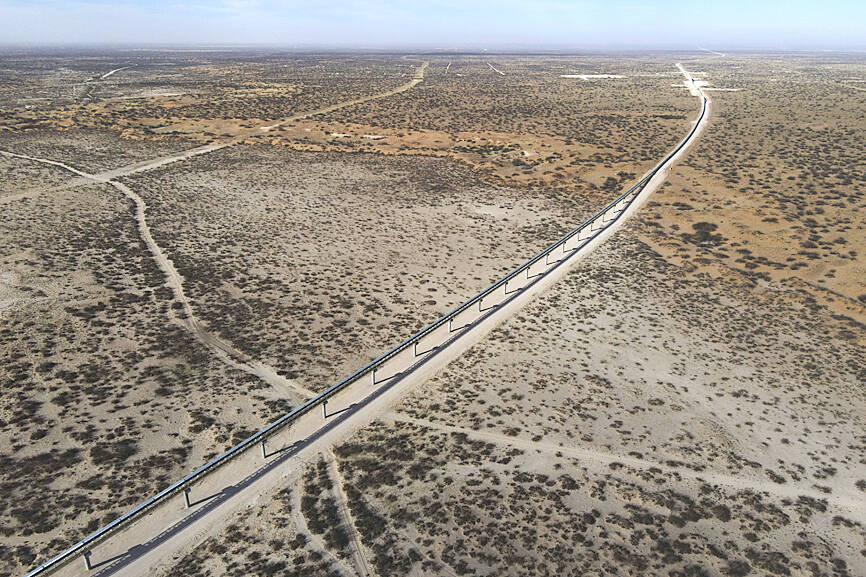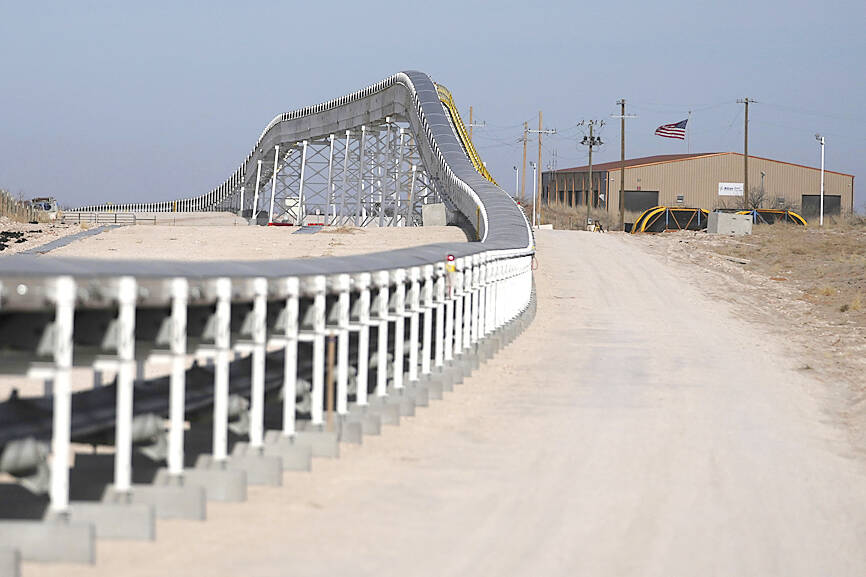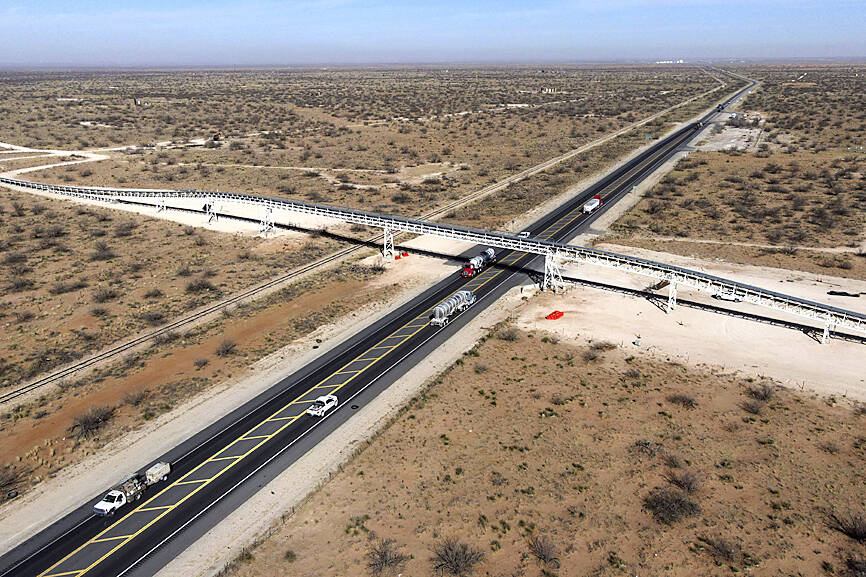It is longer than the width of Rhode Island, snakes across the oil fields of the southwest US and crawls at 16kph — too slow for a truck and too long for a train.
It is a new sight: the longest conveyor belt in the US.
Atlas Energy Solutions, a Texas-based oil field company, installed a 67km-long conveyor belt to transport millions of tonnes of sand for hydraulic fracturing. The belt the company named “The Dune Express” runs from tiny Kermit, Texas, and across state borders into Lea County, New Mexico. Tall and lanky with lids that resemble solar modules, the steel structure could almost be mistaken for a roller coaster.

Photo: AP
In remote West Texas, few people are around to marvel at the unusual machine in Kermit, a city with a population of fewer than 6,000, where the sand is typically hauled by tractor trailers. During fracking, liquid is pumped into the ground at a high pressure to create holes, or fractures, that release oil. The sand helps keep the holes open as water, oil and gas flow through it.
Moving the sand by truck is usually a long and potentially dangerous process, Atlas energy CEO John Turner said.
Massive trucks moving sand and other industrial goods are a common site in the oil-rich Permian Basin and pose a danger to other drivers, he said.

Photo: AP
“Pretty early on, the delivery of sand via truck was not only inefficient, it was dangerous,” he said.
The conveyor belt, with a freight capacity of 11.79 tonnes, was designed to bypass and trudge alongside traffic.
Innovation is not new to the oil and gas industry, nor is the idea to use a conveyor belt to move materials around. Another conveyor belt believed to be the world’s longest conveyor — at 98.17km — carries phosphorous from a mine in Western Sahara on the northwest coast of Africa, according to NASA Earth Observatory.

Photo: AP
When moving sand by truck became a nuisance, an unprecedented and risky investment opportunity arose: constructing a US$400 million machine to streamline the production of hydraulic fracturing.
The company went public in March 2023, in part, to help pay for the conveyor belt and completed its first delivery in January, Turner said.
The sand sits in a tray-shaped pan with a lid that can be removed at any point, but most of it gets offloaded into silos near the Texas and New Mexico border. Along its kilometers-long journey, the sand is sold and sent to fracking companies who move it by truck for the remainder of the trip.
Keeping the rollers on the belt aligned and making sure it runs smoothly are the biggest maintenance obstacles, Turner said.
The rollers are equipped with chips that signal when it is about to fail and need to be replaced, which helps prevent wear and tear and keep the machine running consistently, he said.
The belt cuts through a large oil patch where environmentalists have long raised concerns about the industry disturbing local habitats, including those of the sagebrush lizard, which was listed as an endangered species last year by the US Fish and Wildlife Service.
“In addition to that, we know that the sand will expedite further drilling nearby,” Environment Texas executive director Luke Metzger said. “We could see more drilling than we otherwise would, which means more air pollution, more spills than we otherwise would.”
The Dune Express runs for about 12 to 14 hours a day at about half capacity, but the company expects it to be rolling along at all hours later this year.
In New Mexico, Lea County Commissioner Brad Weber said he hopes the belt alleviates traffic on a parallel highway where vehicle crashes are frequent.
“I believe it’s going to make a very positive impact here,” he said.

SELL-OFF: Investors expect tariff-driven volatility as the local boarse reopens today, while analysts say government support and solid fundamentals would steady sentiment Local investors are bracing for a sharp market downturn today as the nation’s financial markets resume trading following a two-day closure for national holidays before the weekend, with sentiment rattled by US President Donald Trump’s sweeping tariff announcement. Trump’s unveiling of new “reciprocal tariffs” on Wednesday triggered a sell-off in global markets, with the FTSE Taiwan Index Futures — a benchmark for Taiwanese equities traded in Singapore — tumbling 9.2 percent over the past two sessions. Meanwhile, the American depositary receipts (ADRs) of Taiwan Semiconductor Manufacturing Co (TSMC, 台積電), the most heavily weighted stock on the TAIEX, plunged 13.8 percent in

A wave of stop-loss selling and panic selling hit Taiwan's stock market at its opening today, with the weighted index plunging 2,086 points — a drop of more than 9.7 percent — marking the largest intraday point and percentage loss on record. The index bottomed out at 19,212.02, while futures were locked limit-down, with more than 1,000 stocks hitting their daily drop limit. Three heavyweight stocks — Taiwan Semiconductor Manufacturing Co (TSMC, 台積電), Hon Hai Precision Industry Co (Foxconn, 鴻海精密) and MediaTek (聯發科) — hit their limit-down prices as soon as the market opened, falling to NT$848 (US$25.54), NT$138.5 and NT$1,295 respectively. TSMC's

TARIFFS: The global ‘panic atmosphere remains strong,’ and foreign investors have continued to sell their holdings since the start of the year, the Ministry of Finance said The government yesterday authorized the activation of its NT$500 billion (US$15.15 billion) National Stabilization Fund (NSF) to prop up the local stock market after two days of sharp falls in reaction to US President Donald Trump’s new import tariffs. The Ministry of Finance said in a statement after the market close that the steering committee of the fund had been given the go-ahead to intervene in the market to bolster Taiwanese shares in a time of crisis. The fund has been authorized to use its assets “to carry out market stabilization tasks as appropriate to maintain the stability of Taiwan’s

STEEP DECLINE: Yesterday’s drop was the third-steepest in its history, the steepest being Monday’s drop in the wake of the tariff announcement on Wednesday last week Taiwanese stocks continued their heavy sell-off yesterday, as concerns over US tariffs and unwinding of leveraged bets weighed on the market. The benchmark TAIEX plunged 1,068.19 points, or 5.79 percent, to 17,391.76, notching the biggest drop among Asian peers as it hit a 15-month low. The decline came even after the government on late Tuesday authorized the NT$500 billion (US$15.2 billion) National Stabilization Fund (國安基金) to step in to buoy the market amid investors’ worries over tariffs imposed by US President Donald Trump. Yesterday’s decline was the third-steepest in its history, trailing only the declines of 2,065.87 points on Monday and